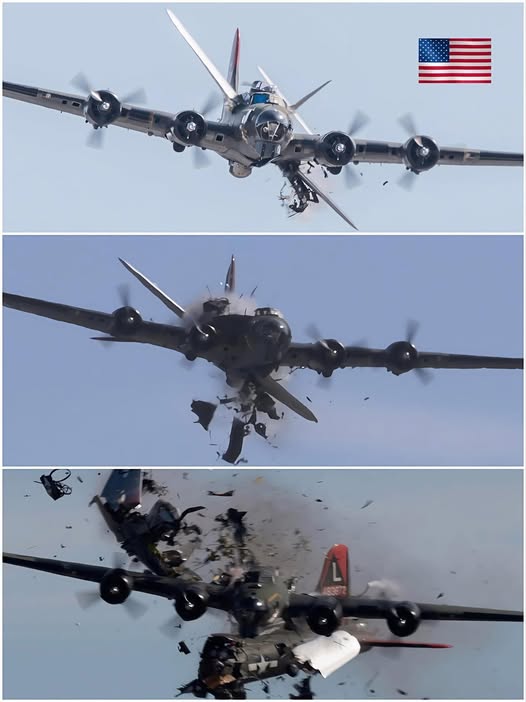In November 2022, a routine air show in Dallas turned into a scene of unimaginable tragedy. Spectators who had gathered to celebrate aviation history were suddenly confronted with a catastrophic accident involving two World War II-era aircraft: a B-17 Flying Fortress and a P-63 Kingcobra. What was intended as a commemorative flight honoring America’s rich aviation heritage ended in disaster, claiming the lives of all crew members on both planes and leaving the crowd in shock.
The Aircraft Involved
The B-17 Flying Fortress is one of the most recognizable bombers from World War II, celebrated for its durability, firepower, and the critical role it played in the Allied campaign over Europe. Known affectionately as the “Flying Fortress,” the B-17 became a symbol of American ingenuity and resilience during the war.
The P-63 Kingcobra, though less widely known than the B-17, is a rare fighter aircraft developed by Bell Aircraft. With its sleek design and impressive speed, the Kingcobra represented the cutting-edge technology of its time. Both planes were meticulously restored and maintained by enthusiasts, allowing modern audiences to witness history firsthand during Heritage Flight demonstrations.
The Heritage Flight Demonstration
Heritage Flight demonstrations are designed to honor America’s aviation legacy. These displays feature vintage aircraft flying in formation, often accompanied by modern military jets, creating a powerful visual tribute to the pilots and aircraft of past wars.
On that fateful day in Dallas, the B-17 and P-63 were participating in one such demonstration. Thousands of spectators, including families, veterans, and aviation enthusiasts, gathered to experience the spectacle. The air was filled with excitement and anticipation as the historic aircraft performed maneuvers in coordinated flight.
The Mid-Air Collision
Tragedy struck when the P-63 Kingcobra accidentally collided with the B-17 Flying Fortress. Witnesses described the moment as a scene from a nightmare: the two planes made contact, sparks flew, and both aircraft began to spiral out of control. Within seconds, the collision turned catastrophic.
The B-17, heavily damaged by the impact, plummeted toward the ground, trailing smoke and debris. Simultaneously, the P-63 caught fire, adding to the chaos. Onlookers below watched in horror as parts of both planes rained down, a stark and terrifying reminder of the risks involved in operating historic aircraft.
The crash instantly claimed the lives of all crew members aboard both planes. The loss was deeply felt within the aviation community and among those who had gathered to honor the history of these remarkable machines.
Witness Accounts
Spectators at the air show described the collision as shocking and surreal. Some recounted hearing the deafening sound of metal striking metal, followed by a roar as flames engulfed the aircraft. Others shared the sight of debris falling from the sky, scattering across the field where families had gathered.
Veterans who were in attendance spoke of the emotional impact of witnessing such a tragedy. Many had flown or worked with similar aircraft and understood both the technical challenges and the inherent dangers involved. Their reaction was a mix of grief for the lost crew members and concern for the spectators who had witnessed the accident.
Emergency Response
Emergency crews acted quickly in the aftermath of the crash. Firefighters and paramedics rushed to the scene to contain fires and assess the situation. Despite their rapid response, there were no survivors. The tragedy highlighted both the bravery and limitations of emergency responders when dealing with high-impact aviation accidents.
Authorities cordoned off the crash site to ensure safety and begin investigations. Teams of investigators from the Federal Aviation Administration (FAA) and the National Transportation Safety Board (NTSB) were dispatched to examine the wreckage, interview witnesses, and determine the cause of the collision.
Investigating the Cause
Preliminary investigations focused on multiple potential factors, including pilot error, mechanical failure, and miscommunication during the flight. Mid-air collisions in air shows are extremely rare, but when they occur, they often involve a combination of human and technical factors.
Experts emphasized that flying vintage aircraft carries unique challenges. These planes are often decades old, and despite careful restoration, they require precise maintenance and exceptional skill to operate. Formation flying, which is essential to Heritage Flights, leaves little margin for error.
The NTSB’s final report, released months after the incident, highlighted the complexity of coordinating multiple historic aircraft in close formation. While definitive conclusions were carefully worded, the report stressed the need for enhanced safety protocols and stricter oversight for air shows involving vintage planes.
The Emotional Impact on the Community
The Dallas air show disaster left an indelible mark on the local community. Families, aviation enthusiasts, and veterans mourned the loss of the crew members, many of whom were well-known and respected within the historic aircraft community.
Memorials and vigils were held in the weeks following the crash. Community leaders and fellow pilots expressed their condolences, emphasizing the importance of remembering the contributions of these pilots and the history these planes represent.
For spectators who witnessed the accident firsthand, the emotional impact was profound. Children and adults alike grappled with the suddenness and severity of the crash, highlighting the human side of aviation safety.
Aviation Safety Lessons
The collision has prompted renewed discussions about air show safety. Experts recommend several measures to reduce the risk of mid-air accidents, including:
- Strict adherence to formation flight regulations and spacing requirements
- Enhanced pilot training specifically for vintage aircraft
- Pre-flight safety briefings for all participating pilots
- Increased communication protocols during demonstrations
- Use of advanced tracking and monitoring technologies
These steps aim to honor the legacy of historic aircraft while ensuring that future air shows remain safe for both pilots and spectators.
Remembering the Legacy of the B-17 and P-63
Despite the tragic ending, the B-17 Flying Fortress and P-63 Kingcobra remain symbols of innovation, courage, and the rich history of aviation. The B-17 is remembered for its critical role in World War II, and the P-63 Kingcobra represents the cutting-edge fighter technology of its era.
Events like the Dallas Heritage Flight are meant to celebrate this history and keep it alive for future generations. While the collision was devastating, the dedication of pilots and enthusiasts continues to honor the legacy of these remarkable aircraft.
Tribute to the Fallen Crew
The lives lost in the Dallas air show collision are a somber reminder of the risks faced by pilots who preserve aviation history. Tributes poured in from around the world, honoring the bravery, skill, and passion of those who flew the B-17 and P-63.
Families of the crew members expressed gratitude for the outpouring of support and emphasized the importance of continuing to educate the public about aviation history. Memorials and ceremonies have ensured that their sacrifice is not forgotten.
Moving Forward
The Dallas air show tragedy has led to increased scrutiny of air show protocols, especially those involving vintage aircraft. Organizers and regulatory bodies are implementing stricter safety measures to prevent similar incidents in the future.
For the aviation community, the disaster serves as a reminder of the delicate balance between honoring history and ensuring safety. While the loss is immeasurable, efforts to improve safety, pilot training, and crowd protection are being strengthened nationwide.
Conclusion
The mid-air collision between the B-17 Flying Fortress and the P-63 Kingcobra at the Dallas air show was a heartbreaking event that shook spectators, families, and the aviation community. The tragedy highlighted both the beauty and danger inherent in vintage aircraft displays.
While the lives lost cannot be replaced, the legacy of these historic planes—and the dedication of those who fly them—continues to inspire. The incident has reinforced the need for rigorous safety measures and serves as a poignant reminder of the risks faced by pilots who work to preserve history.
As the aviation community moves forward, memorials, tributes, and lessons learned ensure that the sacrifices of the Dallas air show crew will never be forgotten, and that future generations can safely experience the wonder of historic flight.




